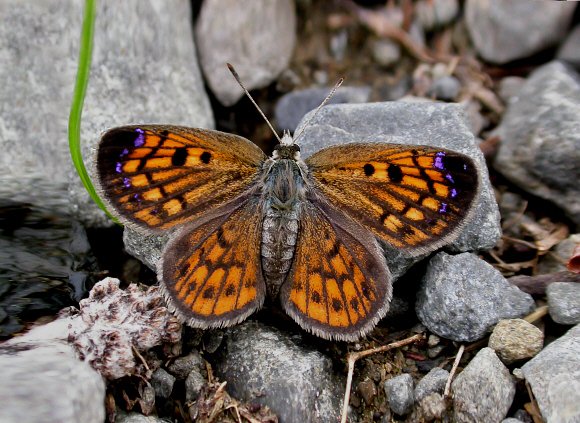
Introduction
The current classification of the genus Lycaena is unsatisfactory and in need of revision. The genus is loosely split into several unofficial groupings, which ultimately will be classified as sub-genera or new genera. Under existing classification there are about 70 Lycaena species, variously distributed across temperate regions of the world.
There were originally thought to be only 4 Lycaena species in New Zealand i.e. salustius, feredayi, boldenarum and rauparaha, but the former boldenarum subspecies tama and caerulea are now recognised as full species, as is edna which was formerly regarded as a subspecies of salustius.
The underside hindwings of boldenarum vary in markings, Examples from some sites are pale and faintly marked. Those from other sites may be boldly patterned with blackish marbling on a grey ground colour. It is not clear at this time if these forms are merely habitat-related morphs or if they represent different subspecies or species.
Lycaena boldenarum is endemic to New Zealand and is found on both islands.
Habitats
This species is found in a wide variety of habitats including grassland, shingle, sand dunes.
-%20Lynton%20Downs-001a.jpg)
Lifecycle
The usual larval foodplant is Muehlenbeckia axillaris but Rumex flexousus is also recorded, and it is possible that other Muehlenbeckia species are also used. The egg is laid singly on a stem or on the underside of leaves. The larva is variable in colour so may be olive-green, yellowish-green, pink or reddish-brown, but always has a diamond-shaped mark on the prothorax. It overwinters when half grown and resumes feeding in the spring. When not feeding it hides beneath small stones. It is often found in association with Chelaner ants but there is no proven symbiotic link or dependency. The pupa can be either light brown or reddish, but the abdomen of both forms is speckled with black. It is secured by the cremaster and a few loose strands of silk to a dead leaf on the ground.

Adult behaviour
Males have a rapid erratic flight but females are more fluttery. Both sexes stay close to the ground, and are only active in bright sunny conditions.

